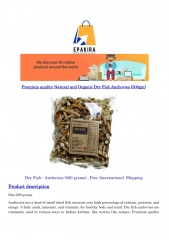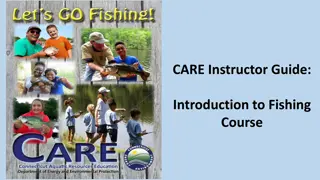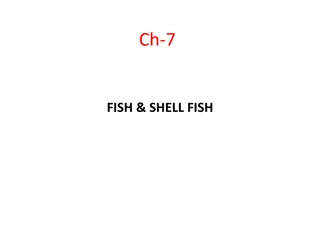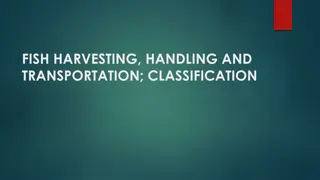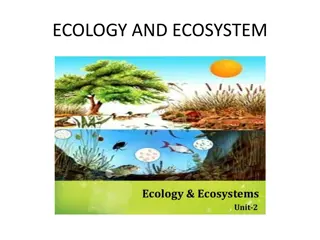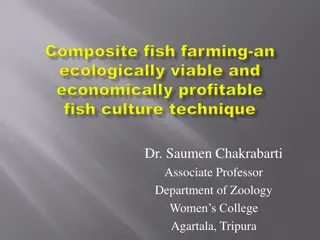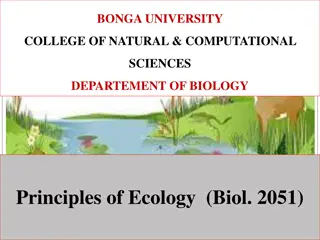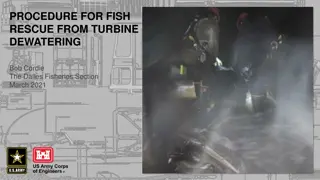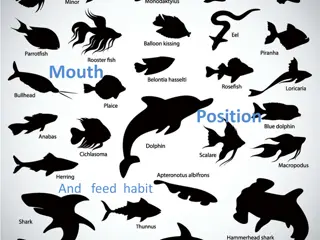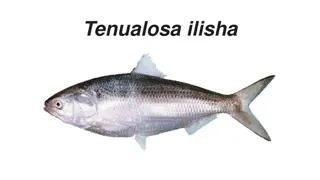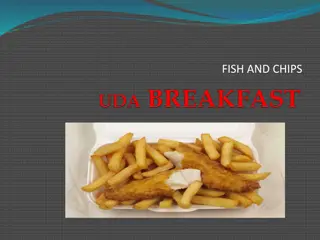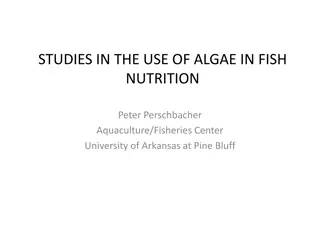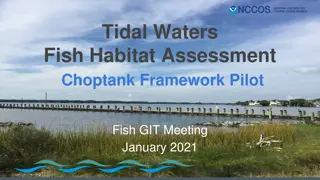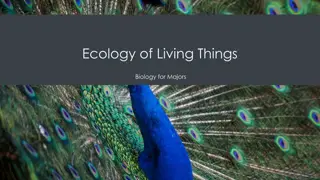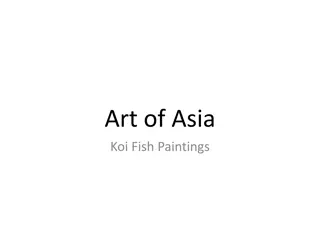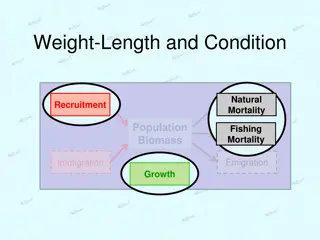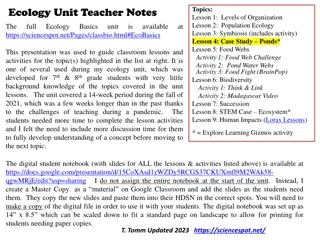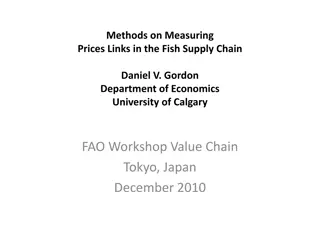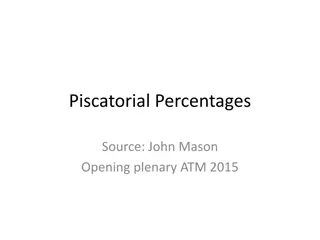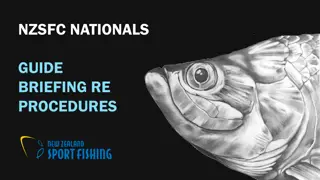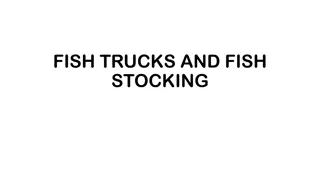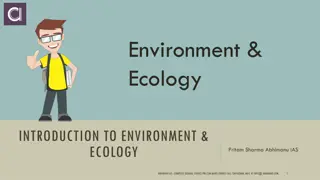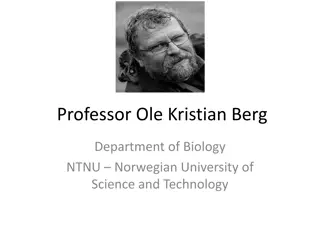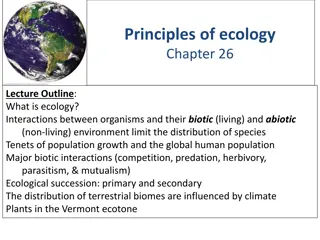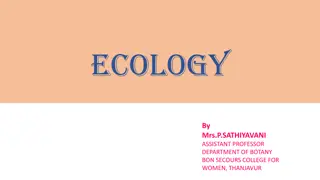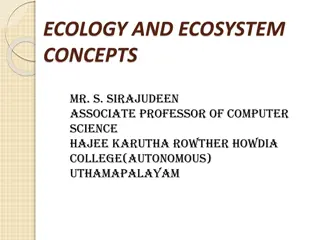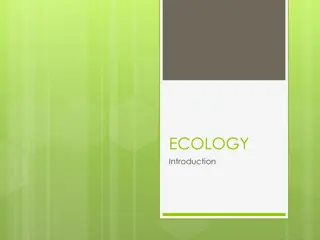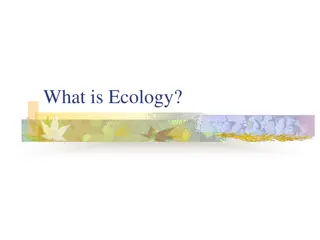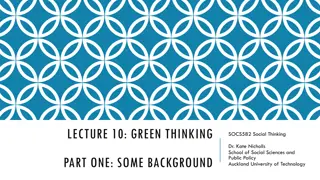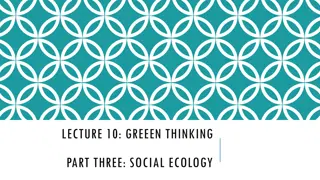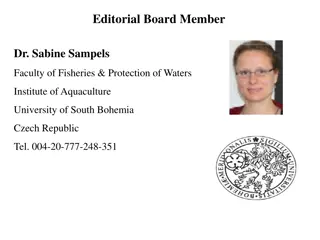Premium quality Natural and Organic Dry Fish Anchovies (500gm)
Dry Fish - Anchovies (500 grams) , free shipping worldwide\n\nProduct description\n\nSize:500 grams\n\nAnchovies are a kind of small dried fish contains very high percentage of calcium, proteins, and omega -3-fatty acids, minerals, and vitamins, for healthy body and mind. Dry fish anchovies are comm
0 views • 3 slides
Understanding Ecology: Interactions Between Organisms and their Environment
Ecology is the scientific study of how living organisms interact with each other and their environment. It delves into the relationships between biotic and abiotic factors, encompassing topics such as the distribution and abundance of organisms, structural adaptations, behavior under natural conditi
2 views • 42 slides
Understanding Ecosystems: Ecological Interactions and Dependencies
Ecology is the study of how organisms interact with their environment, influencing their distribution and abundance. This exploration covers terrestrial and aquatic biomes, energy flow, environmental impacts, adaptations, and global ecosystems, emphasizing the interconnectedness of all living organi
2 views • 58 slides
Understanding Fish Ecology: Interactions, Diversity, and Environmental Factors
Fish ecology involves studying the distribution, interactions, and abundance of fish species in different ecosystems. This lab delves into the divisions of ecology, fish species diversity in marine and freshwater ecosystems, and the environmental factors affecting fish diversity and abundance. Disco
1 views • 7 slides
Introduction to Fishing Course: CARE Instructor Guide
Welcome to the CARE Instructor Guide for the Introduction to Fishing Course. This course covers topics such as rod and reel setup, tackle, knots, rules and regulations, fish identification, ecology, baits, care of catch, and casting. Learn about the CARE program, funded through Sport Fish Restoratio
1 views • 15 slides
All About Fish and Shellfish: Types and Characteristics
Explore the world of seafood with a detailed overview of fin fish, shellfish, and their various sub-categories. Learn about the characteristics of white fish, including flat and round varieties, as well as oily fish. Discover the differences between fin fish and shellfish, such as crustaceans and mo
1 views • 18 slides
Fish Processing and Preservation Methods for Quality and Longevity
Fish are highly perishable and require proper preservation techniques to maintain their quality and freshness. Methods such as chilling, freezing, and other preservation techniques are employed to extend the shelf life of fish for short and long durations. Quick freezing is preferred for long-term s
1 views • 17 slides
Overview of Fish Harvesting, Handling, and Transportation
Fish harvesting is crucial for providing valuable animal protein, with India being a key player in fish production. Fisheries are categorized into fin and non-fin types, with capture and culture fisheries being common practices. Capture fisheries involve natural species recruitment in sea and inland
2 views • 16 slides
Understanding Ecology and Ecosystem: A Comprehensive Overview
Ecology, derived from the Greek word "oikologie," explores the interactions between organisms and their environment. The study encompasses various branches like human ecology, population ecology, and habitat ecology, focusing on the relationships within ecosystems. An ecosystem, defined by A.G. Tans
1 views • 68 slides
Fish Breeding and Spawn Management Techniques by Dr. S.P. Sahu
Dr. S.P. Sahu, an Assistant Professor at Bihar Veterinary College in Patna, provides valuable insights into fish breeding and spawn management. The content covers fish seed collection, procurement methods, fry identification, and confined water breeding techniques. Detailed information on Indian maj
2 views • 26 slides
Composite Fish Farming: An Innovative Aquaculture Technique
Composite fish farming is a popular aquaculture technique where different compatible fish species are cultured together in ponds to maximize fish production. Researchers from India and abroad have contributed significantly to this field. The practice involves combining Indian major carps like Catla,
1 views • 19 slides
Understanding Media Ecology: Impact of Communication Technology
Media ecology is a theoretical concept analyzing the influence of media and communication technology on human culture. Neil Postman, a prominent figure in the field, delves into how communication media affect human perception, understanding, and values. This study views media as environments shaping
4 views • 23 slides
Principles of Ecology: Understanding Organism-Environment Interactions
Ecology is the scientific study of how living organisms interact with each other and their environment. It involves understanding organisms at their native habitats, from individuals to ecosystems. The discipline encompasses various branches and focuses on the relationships shaping the distribution
1 views • 14 slides
Guide to Fish Rescue from Turbine Dewatering Process
Detailed procedure for rescuing fish from turbine dewatering, including steps like hoisting sturgeon, salvaging fish in tanks, and using gantry cranes to transport them. The process involves specialized equipment and careful handling to ensure the safety of the fish. Images illustrate key steps in t
2 views • 9 slides
Understanding Fish Mouth Positions and Feeding Habits
The position of a fish's mouth reveals valuable information about its feeding habits, behavior, and lifestyle. Fish mouths can be categorized as superior (upward-facing), terminal (forward-facing), or inferior (downward-facing), each adapted for specific feeding strategies. Superior mouths are ideal
5 views • 10 slides
Understanding Routes of Drug Administration in Fish Pharmacology
Fish pharmacology is crucial for treating fish diseases effectively using drugs. Factors like water quality, pathogens, mortality rate, legal aspects, and economics need consideration. Different routes of drug administration in fish include water medication, immersion or dipping, hyperosmotic infilt
1 views • 20 slides
All You Need to Know About Hilsa Fish
Hilsa herring, also known as Hilsa shad, is a sought-after food fish in the Indian Subcontinent, particularly in Bangladesh, India, and West Bengal. This marine species belongs to the herring family, Clupeidae, and can grow up to 60cm in length. It is an anadromous fish, schooling in coastal waters
0 views • 5 slides
The History and Recipe of Fish and Chips
Fish and chips originated in England as a popular meal among the working classes during the 19th century. The dish consists of fried fish and deep-fried potato slices, traditionally served in paper wrappings. The history of fish and chips dates back to the rapid development of trawl fishing in the N
4 views • 7 slides
Studies in the Use of Algae in Fish Nutrition by Dr. Peter Perschbacher
Dr. Peter Perschbacher, an Associate Professor at the University of Arkansas, specializes in exploring the benefits of algae in fish nutrition. His research interests include polycultures, algae as fish meal replacements, alligator gar ecology, and more. He has received numerous honors and awards fo
0 views • 28 slides
Tidal Waters Fish Habitat Assessment Choptank Framework Pilot Fish GIT Meeting January 2021
The Tidal Waters Fish Habitat Assessment Choptank Framework Pilot Fish GIT Meeting held in January 2021 discussed background, drivers, and the selection of the Choptank River as a candidate tributary. The project team, responsible parties, actions, and timeline for developing an analytical framework
0 views • 17 slides
Understanding Ecology: Interactions and Environments in Biology
Ecology is the study of interactions between living organisms and their environment. It involves levels of research such as animal ecology, plant ecology, and more, while also exploring the biosphere's impact, biogeography, species distribution patterns, and energy sources like sunlight. Ocean upwel
1 views • 80 slides
Symbolism and Beauty of Koi Fish in Asian Art
Koi fish hold special significance in Asian culture, symbolizing perseverance, strength, prosperity, and good luck. They are popular subjects in paintings due to their rich symbolism rooted in legends and traditions from countries like China and Japan. The fish's journey from carp to dragons in Chin
0 views • 13 slides
Understanding Fish Condition Metrics and Length-Weight Relationships
Fish condition metrics and length-weight relationships play a crucial role in assessing the health and growth of fish populations. These metrics help determine factors such as weight relative to length and overall physical health. By utilizing models and examining relationships between length and we
0 views • 16 slides
Managing Fish Barriers in Scotland: Improving Water Environments
The management plans and implementation of fish barriers measures in Scotland aim to address key pressures on the water environment, such as fish migration, physical condition, and pollution. The initiative involves categorizing barriers, taking actions on fish migration, scoping barriers, assessing
0 views • 9 slides
Comprehensive Ecology Unit for Middle School Students
Engage 7th & 8th grade students in a 14-week ecology unit covering topics like levels of organization, population ecology, symbiosis, biodiversity, human impacts, and more. Utilize digital notebooks, interactive activities, and exploration tools to enhance learning and understanding. Access resource
0 views • 18 slides
Analysis of Price Links in the Fish Supply Chain
This research delves into methods for measuring price links within the fish supply chain, considering factors such as demand, marketing inputs, and price transmission. The study explores the elasticity of demand, substitution possibilities, and models to assess price and margin flexibilities in the
0 views • 24 slides
Solving the Piscatorial Percentages Problem
The "Piscatorial Percentages" problem involves a fish tank with 200 fish, 98% of which are small. By removing a certain number of small fish, the goal is to leave 96% of the total fish as small fish. Two approaches are discussed to reach the solution, resulting in the removal of 100 small fish in bo
0 views • 25 slides
NZSFC Nationals Guide - Fish Counting Procedures and Point System
Learn the detailed procedures for counting and weighing fish at the NZSFC Nationals, including point-based and weight-based scoring systems, species trophies, Varta Cup awards, and line weight requirements for different fish species. Understand the formula for calculating points based on the weight
0 views • 12 slides
Understanding Aquatic Epidemiology in Fish Populations
Aquatic epidemiology is a crucial branch of science that focuses on describing the health, diseases, and welfare of fish populations. It involves studying diseases in wild and hatchery-raised fish, identifying factors influencing disease occurrence, and conducting diagnostic investigations to mainta
0 views • 12 slides
Challenges and Solutions in Fish Truck Fleet Logistics
Addressing the complexities of managing a large and aging fish truck fleet, the challenges include maintaining safety, operational costs, fleet efficiency, and replacement timing. Solutions involve collaboration with hatchery managers, experts' advice on fleet replacement, and working with agencies
0 views • 11 slides
Introduction to Ecology and Environment Studies
Ecology is the study of the relationship between organisms and their environment, while the environment refers to the surroundings that influence living organisms. The biosphere is divided into the atmosphere, lithosphere, and hydrosphere. Terms in ecology include species, populations, communities,
0 views • 13 slides
Research Contributions of Professor Ole Kristian Berg in Fish Ecology and Aquaculture
Professor Ole Kristian Berg from the Department of Biology at NTNU has made significant contributions to the fields of fish ecology and aquaculture. His research focuses on topics such as biotic interactions, competitive asymmetries, conservation biology, lipid stores in fish, and the effects of hyd
0 views • 5 slides
Exploring Ecology: Interactions, Distribution, and Population Dynamics
Ecology delves into the relationships between organisms and their environment, understanding factors that limit species distribution, major interactions like competition and predation, as well as population growth patterns. This includes the influence of biotic and abiotic factors, ecological succes
0 views • 30 slides
Understanding Ecology: Key Concepts and Types Explained
Ecology, a vital branch of science, delves into the relationships between organisms and their environment. It encompasses biotic and abiotic factors, studying how living and non-living elements interact within ecosystems. Biotic components include living organisms like plants and animals, while abio
0 views • 7 slides
Ecology and Ecosystem Concepts: Understanding Interrelationships in Nature
Ecology explores the interconnections between living organisms and their environment, dating back to zoologist Geoffroy St. Hilaire's early proposal in 1859. The term "ecology" originates from the Greek words for house and discourse, emphasizing the study of organisms within their habitat. Ecosystem
0 views • 36 slides
Exploring Ecology: Interactions and Environments
Dive into the world of ecology, where organisms interact and rely on each other and their surroundings. Understand the concepts of populations, communities, ecosystems, biomes, and the biosphere. Explore the vocabulary of ecology, from individual organisms to entire biomes. Learn about food chains,
0 views • 14 slides
Understanding Ecology: Interactions in the Environment
Ecology, originating from the Greek words "Oikos" and "Logos," is the study of interactions between living and non-living components in the environment. It encompasses the relationships between plants, animals, microorganisms, and abiotic factors like light, water, nutrients, and atmosphere. Studyin
0 views • 16 slides
Exploring Green Thinking: Societal Perspectives on Environment and Ecology
Delve into the realm of green thinking through the eyes of social sciences in this lecture by Dr. Kate Nicholls at Auckland University of Technology. The discourse ranges from traditional Western views on nature to the rise of the green movement, including discussions on deep ecology, social ecology
0 views • 9 slides
Exploring Social Ecology and Anarchism: A Path to Sustainable Future
Social ecology emphasizes the interconnectedness between social issues and environmental problems, advocating for a society without domination or centralized control. Anarchism, often associated with social ecology, critiques hierarchy and promotes cooperation. The affinity between feminism and ecol
0 views • 8 slides
Dr. Sabine Sampels: Research on Aquaculture, Fish Quality, and Human Health
Dr. Sabine Sampels, a member of the Editorial Board at the University of South Bohemia, Czech Republic, specializes in studying the effects of fish consumption on human health, animal nutrition on fish quality, and lipid metabolism. With a background in Food Chemistry and extensive research experien
0 views • 25 slides
